
Blu Tack is a reusable putty-like pressure-sensitive adhesive produced by Bostik, commonly used to attach lightweight objects to walls, doors or other dry surfaces. Traditionally blue, it is also available in other colours. Generic versions of the product are also available from other manufacturers. The spelling now used is without a hyphen.

Plumbing is any system that conveys fluids for a wide range of applications. Plumbing uses pipes, valves, plumbing fixtures, tanks, and other apparatuses to convey fluids. Heating and cooling (HVAC), waste removal, and potable water delivery are among the most common uses for plumbing, but it is not limited to these applications. The word derives from the Latin for lead, plumbum, as the first effective pipes used in the Roman era were lead pipes.
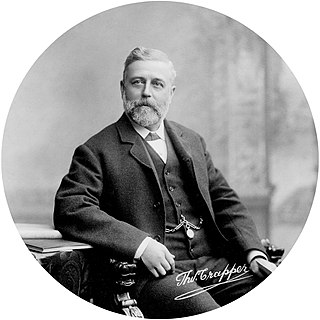
Thomas Crapper was an English businessman and plumber. He founded Thomas Crapper & Co in London, a sanitary equipment company. Crapper held nine patents, three of them for water closet improvements such as the floating ballcock. He improved the S-bend plumbing trap in 1880 by inventing the U-bend. The firm's lavatorial equipment was manufactured at premises in nearby Marlborough Road. The company owned the world's first bath, toilet and sink showroom in King's Road. Crapper was noted for the quality of his products and received several royal warrants.
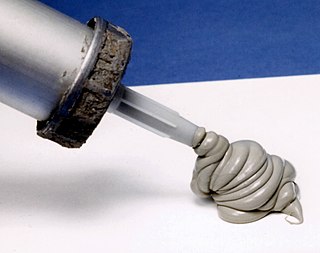
A silicone or polysiloxane are polymers made up of siloxane (−R2Si−O−SiR2−, where R = organic group). They are typically colorless, oils or rubber-like substances. Silicones are used in sealants, adhesives, lubricants, medicine, cooking utensils, and thermal and electrical insulation. Some common forms include silicone oil, silicone grease, silicone rubber, silicone resin, and silicone caulk.

A sink – also known by other names including sinker, washbowl, hand basin, and wash basin – is a bowl-shaped plumbing fixture used for washing hands, dishwashing, and other purposes. Sinks have taps (faucets) that supply hot and cold water and may include a spray feature to be used for faster rinsing. They also include a drain to remove used water; this drain may itself include a strainer and/or shut-off device and an overflow-prevention device. Sinks may also have an integrated soap dispenser. Many sinks, especially in kitchens, are installed adjacent to or inside a counter.

A plumber is a tradesperson who specializes in installing and maintaining systems used for potable (drinking) water, sewage and drainage in plumbing systems.
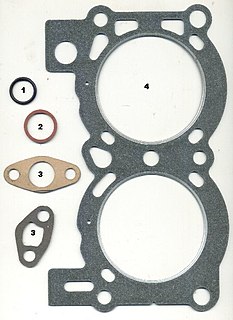
A gasket is a mechanical seal which fills the space between two or more mating surfaces, generally to prevent leakage from or into the joined objects while under compression.

Caulk or caulking is a material used to seal joints or seams against leakage in various structures and piping.
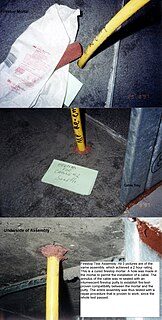
Putty is a material with high plasticity, similar in texture to clay or dough, typically used in domestic construction and repair as a sealant or filler. Although some types of putty (typically those using linseed oil slowly polymerise and become stiff, many putties can be reworked indefinitely, in contrast to other types of filler which typically set solid relatively rapidly.

American National Standard Pipe Thread standards, often called national pipe thread (NPT) standards for short, are U.S. national technical standards for screw threads used on threaded pipes and pipe fittings. They include both tapered and straight thread series for various purposes including rigidity, pressure-tight sealing, or both. The various types are each named with a symbol and a full name; examples of the symbols include NPT, NPS, NPTF, NPSC, and others.
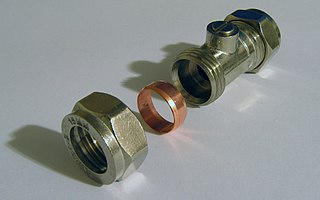
A compression fitting is a fitting used in plumbing and electrical conduit systems to join two tubes or thin-walled pipes together. In instances where two pipes made of dissimilar materials are to be joined, the fittings will be made of one or more compatible materials appropriate for the connection. Compression fittings for attaching tubing (piping) commonly have ferrules in them.
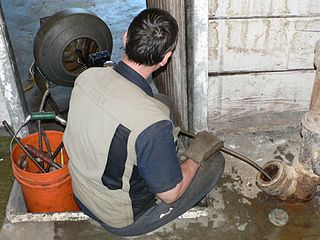
A plumber's snake or drain snake is a slender, flexible auger used to dislodge clogs in plumbing. The plumber's snake is often reserved for difficult clogs that cannot be loosened with a plunger. It is also sometimes called a toilet jack. A plumbers snake is often used by plumbers to clear a clogged drain pipe or sanitary sewer.
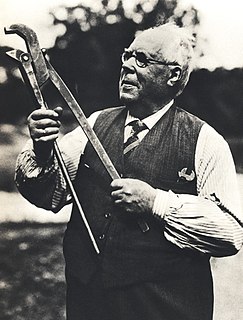
A plumber wrench is a pipe wrench used to rotate plumbing pipes. It is adjusted to different pipe diameters by rotating the key ring. Its advantage is that it grips with significant force without needing to engage a nut. However, if used carelessly, it can dent or break the pipe. It can also be used on nuts and other flat engagement points. It works perfectly in situations where there are hexagon-shaped nuts to be adjusted.

A threaded pipe is a pipe with screw-threaded ends for assembly.

Sealant is a substance used to block the passage of fluids through the surface or joints or openings in materials, a type of mechanical seal. In building construction sealant is sometimes synonymous with caulking and also serve the purposes of blocking dust, sound and heat transmission. Sealants may be weak or strong, flexible or rigid, permanent or temporary. Sealants are not adhesives but some have adhesive qualities and are called adhesive-sealants or structural sealants.

Thread seal tape is a polytetrafluoroethylene (PTFE) film tape commonly used in plumbing for sealing pipe threads. The tape is sold cut to specific widths and wound on a spool, making it easy to wind around pipe threads. Thread seal tape lubricates allowing for a deeper seating of the threads, and it helps prevent the threads from seizing when being unscrewed. The tape also works as a deformable filler and thread lubricant, helping to seal the joint without hardening or making it more difficult to tighten, and instead making it easier to tighten.

A fitting or adapter is used in pipe systems to connect straight sections of pipe or tube, adapt to different sizes or shapes, and for other purposes such as regulating fluid flow. These fittings are used in plumbing to manipulate the conveyance of water, gas, or liquid waste in domestic or commercial environments, within a system of pipes or tubes.

Putty is a village in New South Wales, Australia in Singleton Shire. It is north west of Sydney on the Putty Road between Windsor and Singleton.
Selleys is an Australian company which produces household do it yourself and cleaning products as well as adhesives and sealants for the trade market. It is widely known for recent products such as Selleys Liquid Nails, Selleys No More Gaps and Selleys All Clear. Selleys Metallic Cement and Selleys UniFix preceded these products. Many of their products are sold throughout Asia and have become extremely popular in households Australia-wide due to their durability and availability.

Packing is the process and/or the materials used in filling both service penetrations and building joints with backer materials as approved components within a firestop.

















